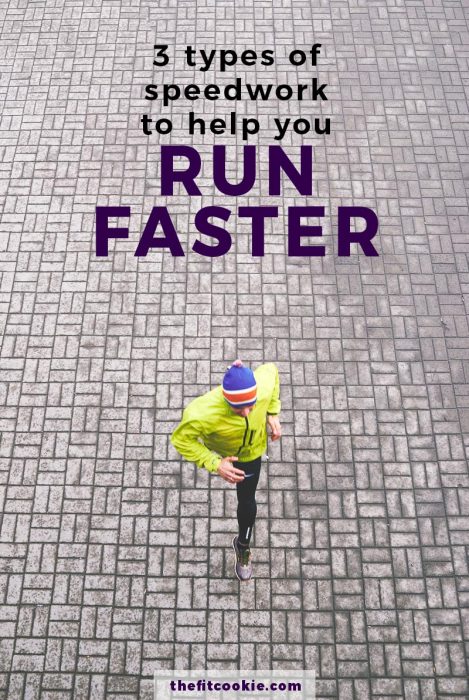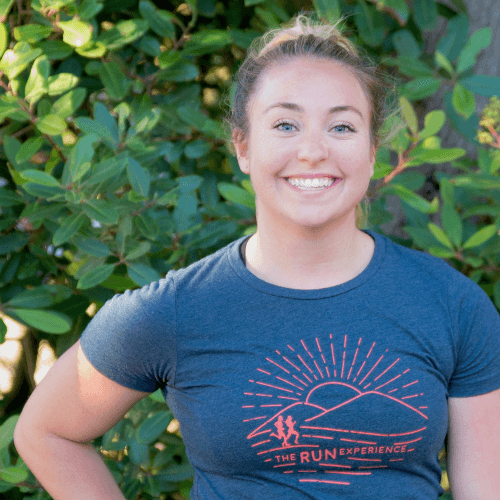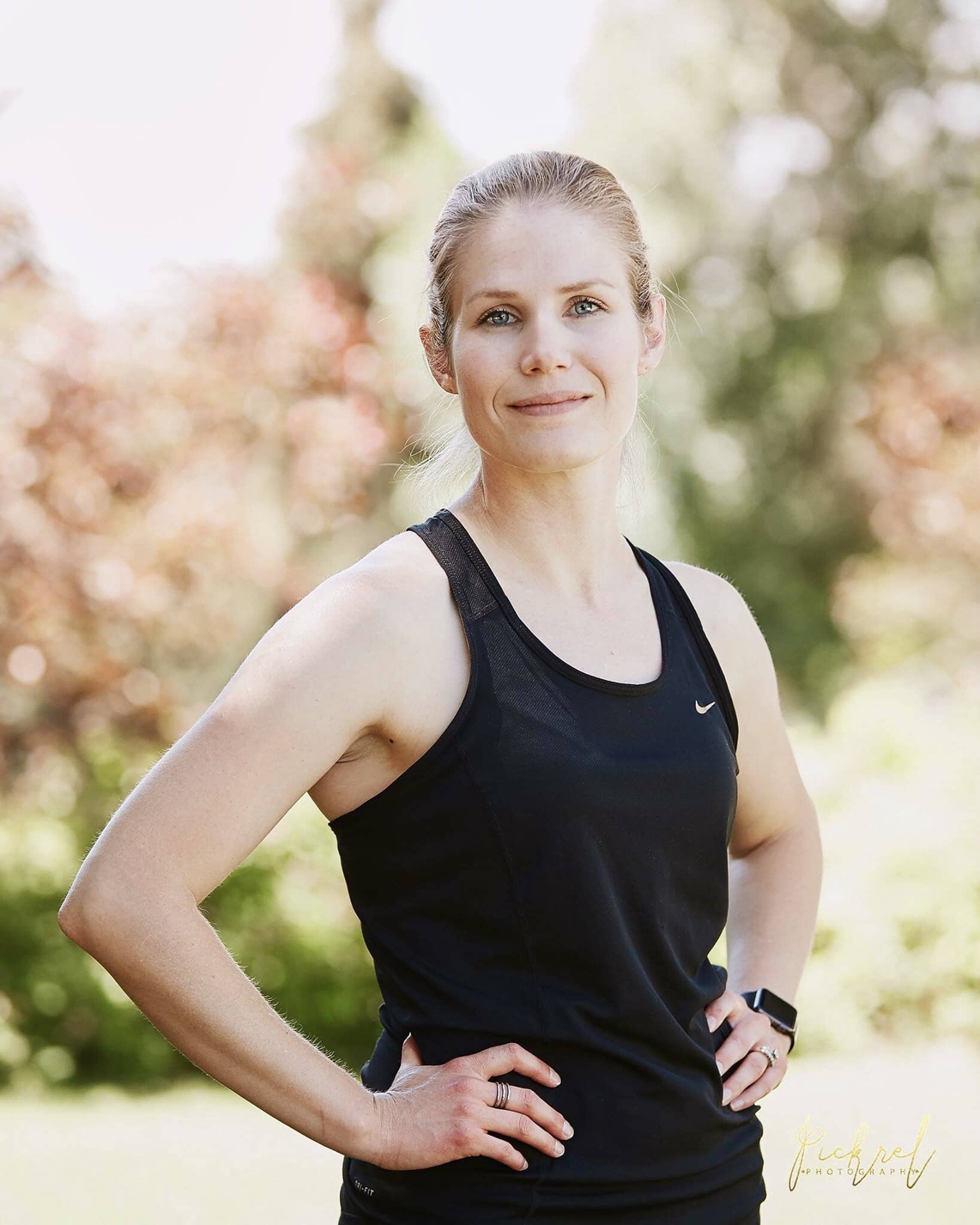Want to increase your running speed for an upcoming race? Here are 3 types of speed work to help you run faster and improve your fitness level

Hey friends, I’ve got another fitness post for you! It’s been a while since I’ve posted much about fitness, I have torn labral cartilage in my left hip (thanks to FAI impingement), so I’m going to have surgery on it in a couple of weeks (I’ll share about my surgery and recovery in a few months).
Since I’m having hip problems and IT band problems, I have had to put off running and high impact activity for a while and focus on easy workouts like walking, elliptical, and some strength training. I have a couple of surgeries lined up for 2019, so hopefully I’ll be able to return to running again this fall. Crossing my fingers!!
In the meantime, I have a guest fitness post for you today from Holly Martin, a running coach and personal trainer at The Run Experience. Enjoy!
3 Types Of Speed Work To Help You Run Faster by Holly Martin
Whether you are in the middle of a marathon training plan or just running around the block to clear your head, we all strive to run faster.
Wondering how to run faster? Get your body used to the speed. Our bodies reject the unfamiliar, and that’s what makes running faster so difficult. The minute our legs start to turn over at a quicker tempo than what is natural, the body starts sending us panic signals.
In this post, we’ve got three speed work drills to combat that panic. These drills will introduce a quicker pace to your body in a gradual manner. This way, your muscles will learn how to run faster in manageable doses.
Work any of these drills into your training once or twice a week over time, so that your body gets used to race pace before race day.
How To Run Faster: Fartlek
Swedish for “speed play,” Fartlek is a great speed workout to add into any level of training, from beginning runners to advanced racers.
This workout helps get runners used to turning their feet over more quickly than they’re used to.
So what are the specifics of this workout? There really aren’t any. Fartlek simply implies that you’re mixing up your speed, and moving your feet faster than you normally would.
How do we work Fartleks into our runs? These workouts to get faster are best for a shorter run, or a run that lasts about 20-30 minutes. If your short runs are shorter than that, no worries! Whatever a “short run” is to you, that is the time to work in Fartleks.
fartlek
Avoid incorporating Fartleks in on your recovery days from a long run. Save them for a day when you feel fresh and your run is on the shorter side.
If you’re running outside, pick a route you are familiar with. When you’re coming up on a particular landmark, increase your speed for the 15-20 seconds leading up to that spot. If you’re on a treadmill or a track, you can work in these Fartleks at a particular time or distance in your run.
You’re not sprinting here. You are just turning your feet over more quickly than you do in your normal pace. Once you get to that landmark, time, or distance, return to your normal run pace.
Check out our post with tips for beginning runners
These are great for beginners to learn how to run faster because you control the specifics. The quick-pace portions can be as long or as short, and as frequent or as infrequent as you’d like.
Just keep yourself honest about them and push yourself to a pace that is faster than normal, but is still sustainable.
How To Run Faster: Tempo Run
Once you’ve gotten used to that quick turnover in a short Fartlek, start to work tempo runs into your training plan.
Tempo runs work best during a medium distance run. Again, this means whatever a medium distance run is for you. The time and distance will vary depending on your skill level or what you’re training for, and that’s totally fine.
Just like with the Fartlek, you want to be feeling relatively fresh on a tempo run. And tempo runs are used by runners at all levels, no matter if the runner is training for a race or not.
tempo run
Start your mid-distance run at your normal pace. Incorporate a good warm-up and then get going as fast as you typically would.
Depending on how long your run is, figure out a time period that constitutes the “middle” of the run. This may be a mile for someone training for a 5K, and this may be 10 miles for someone training working on a marathon training plan. This is completely individual.
All you’re going to do for this tempo run is try to achieve your “race pace” for that middle chunk of the run. If you’re just starting out your training, going just a bit slower than your race pace is fine.
Use this tempo run to get your body used to its goal. And take comfort in the fact that for these workouts, you do not need to maintain that pace the whole time. You can return to a more comfortable speed for the end of the run.
Incorporating these tempo runs over time will get the body used to your desired speed. And as the body gets used to it, it will stop sending you those “panic signals” you may feel when you first started running at tempo.
Work these tempo runs in on your medium distance days in order to gradually achieve your desired pace.
How To Run Faster: Intervals
Interval training is most useful, and recommended, for training sessions closer to a race. If you’re not training for a race, incorporate these after you’ve been training steadily for a while, and are physically and mentally ready to push yourself.
There are many different versions of interval training, but no matter the format, these runs depend on effort level.
interval training
Think of your running on a scale from 1-10, 10 being maximum, all-out effort. If you’re training for a marathon, your 7/10 is going to look quite different than the 7/10 of someone who is training for a 5K.
You can calculate these effort levels using your race pace and adjusting from there, or you can simply just gauge your own perceived effort through trial and error.
So interval runs will look different on everyone, but they are still a highly effective tool.
Interval workouts are like mini, repeated tempo runs. Maybe you’ll go out and do 10 repeats of a certain distance at 7/10 effort. If you’re on a track, 400m is usually a good starting interval distance.
Or you could do a few starting intervals at 5/10 and work your way up to a 9/10. You can design your workout however you’d like.
Check out our interval training tips!
No matter how many repetitions or intervals you’re doing, try not to let yourself totally cool down in between them. This is especially important when training for a race, because you want to get your body used to race-level stress and fatigue.
Take as much time in between intervals as you need to catch your breath, but don’t let your heart rate return to its resting state, as that is not representative of what race day will be like, and it diminishes the usefulness of intervals.
Now you have three speed workouts that will teach your body how to run faster. All three have the same goal in mind: gradual introduction of speed. You are capable of running faster than you think, it’s just a matter of quieting those panic signals the body wants to send.
Work these drills in once or twice a week, and trust your body’s ability to hit that race pace, or whatever speed you desire.
About Author:

Holly Martin is a San Francisco-based running coach and personal trainer. With a 20+ year background in dance, Holly brings a strong focus on technique and mobility to all of her coachings. Currently, she coaches online with The Run Experience, an online training community that specializes in providing marathon training, beginner running programs, workouts and more. She trains clients at Midline Training and Nfinite Strength. Get in touch with her to learn more about how to start running for beginners and other advanced running tips.

Sarah Jane Parker is the founder, recipe creator, and photographer behind The Fit Cookie. She’s a food allergy mom and healthy living blogger based in Wyoming. Sarah is also an ACSM Certified Personal Trainer, ACE Certified Health Coach, Revolution Running certified running coach, and an ACE Certified Fitness Nutrition Specialist

I like that you state that tempo runs can help you start at a medium distance. My daughter has been looking for ways that she can get better at her high school races. I will send her this information so she can start looking for somewhere that offers speedwork training.